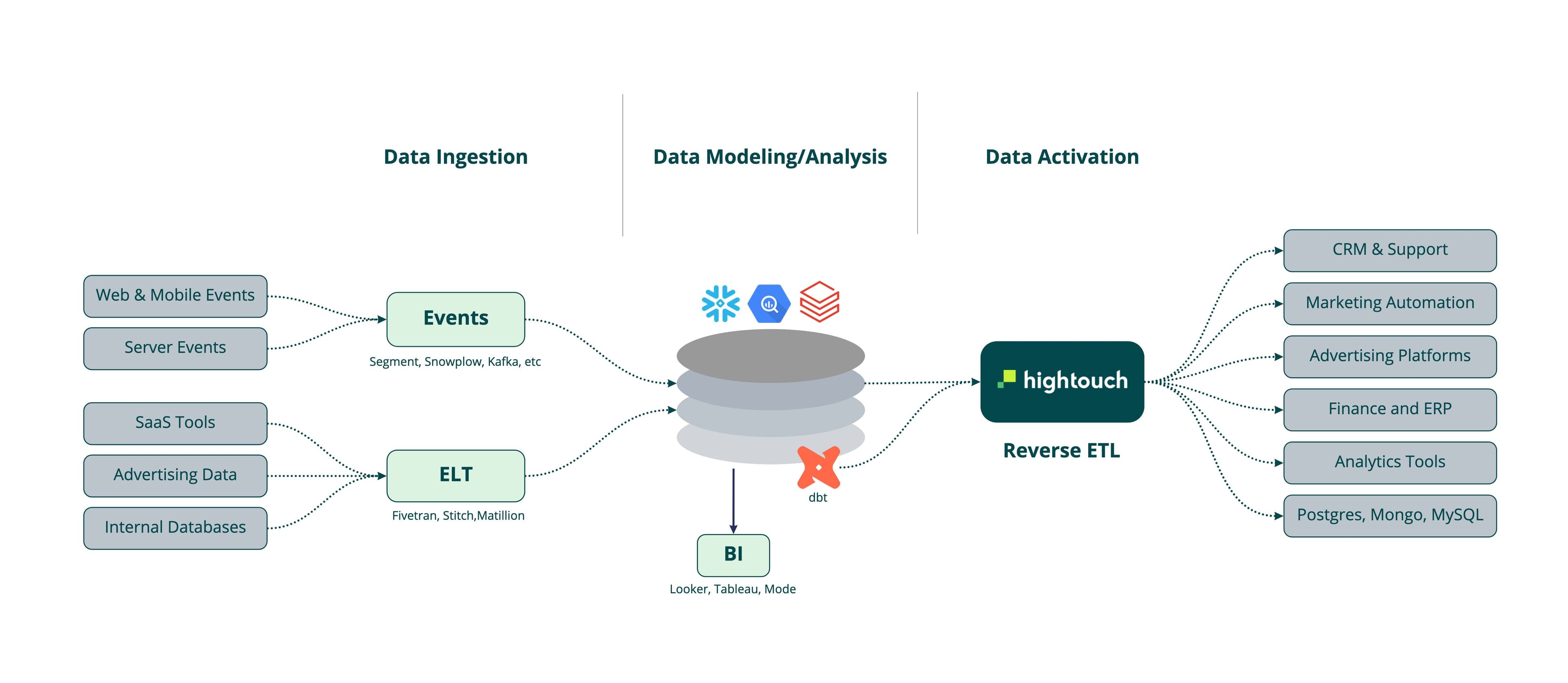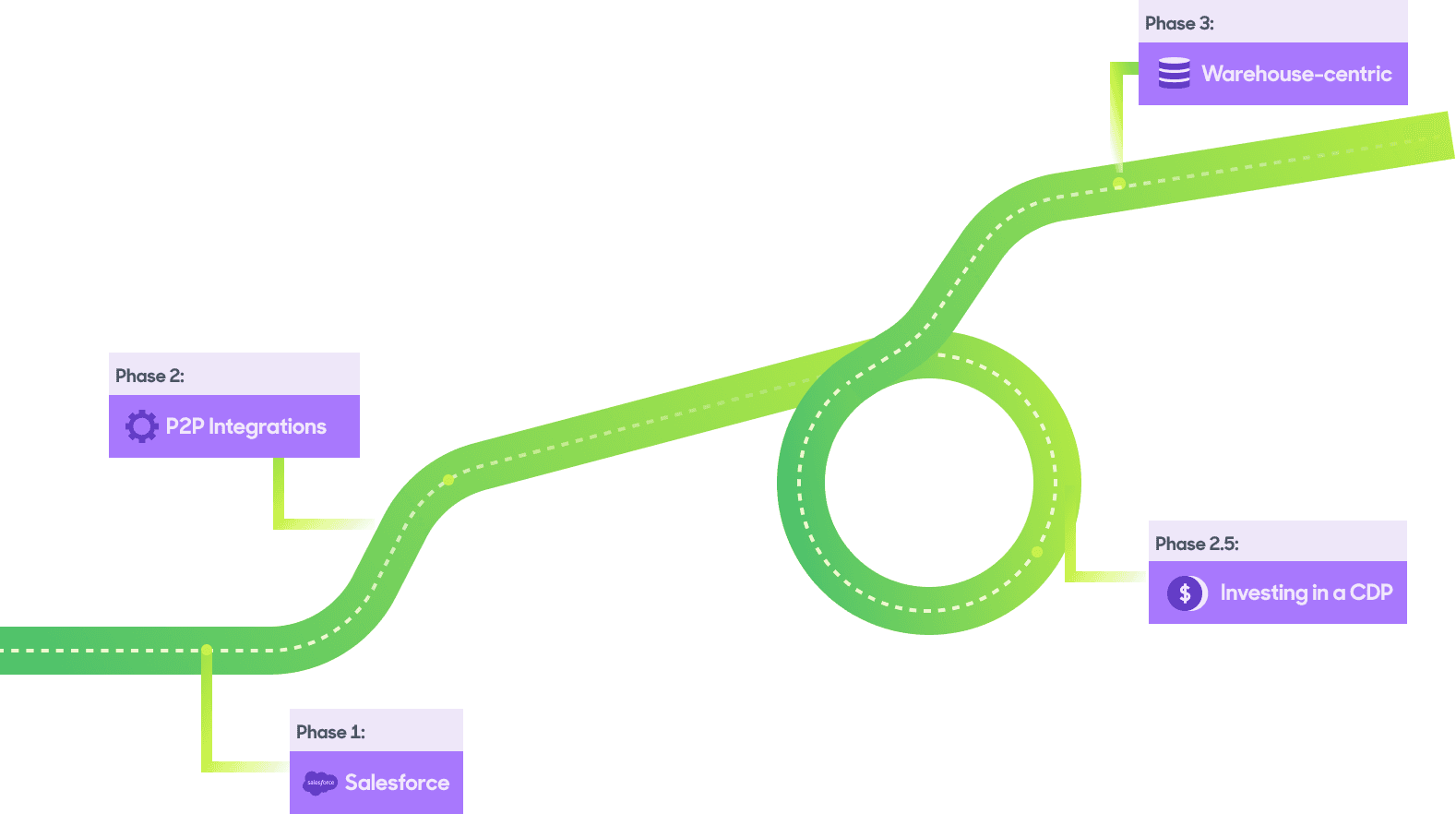Dear CRM, I’ve fallen in love with the data warehouse
Why it's time to embrace the data warehouse as your source of truth
Brian Kotlyar
September 19, 2022
|9 minutes

This week, thousands of people will convene in downtown San Francisco for the preeminent enterprise software event of the year: Salesforce Dreamforce. Amidst all the conversations about Apex code and forecasting automation, you’re likely to hear one phrase over and over and over again: “data warehouse.” If Salesforce is the brick foundation upon which businesses are built, the cloud data warehouse is the ivy that has grown into the cracks and re-leveled things in all kinds of unpredictable ways.
I believe that the next 12 months represent a reckoning for the relationship between CRM and cloud data warehouses—and the outcome is actually already clear: the data warehouse is going to displace CRM as the source of truth in most businesses.
We’re hearing it from our customers every day: “The warehouse has all of my most important data, but Salesforce is where my teams work. What do I do?” And I can only assume that Salesforce is hearing it as well, with their pre-announcement of a deeper Snowflake integration. The fact is, enterprise architectures are changing to accommodate the warehouse, not because they want to, but because they HAVE to.
This is happening because of fundamental issues in how CRM was conceived and deployed in a pre-cloud data warehouse world. If you haven’t checked out our original post on the topic, I recommend spending a few minutes reading it. If you’ve already seen it, then - onwards!
The past: “If It’s Not in Salesforce, It Doesn’t Exist.”
Salesforce changed the world. As the first SaaS app to achieve record growth, it revolutionized how business software applications are built and delivered. And its killer app was the lifeblood of every company—customer relationship management.
In a world where “what did my rep do yesterday?” is the MOST important thing, Salesforce reigns supreme. This led to the rise of the famous/infamous expression, “If it’s not in Salesforce, it doesn’t exist.” It’s the place where every salesperson stores a record of every customer interaction and manages their forecast for revenue contribution to the business. It was only natural for Salesforce to become the nexus of nearly all important customer-facing information, reporting, and insight.
Times Have Changed
In today’s world, what your rep did yesterday is still an important thing. But it’s not the ONLY important thing. Don't get me wrong–it still matters. But things fall apart as soon as you start asking more complex questions. Questions like:
- What did my customer do yesterday in my product or on my website?
- What’s the billing status of that customer?
- What’s the anticipated lifetime value of that prospect?
- What’s the churn propensity of that customer?
And yet, we still need to know these things and then take action on them quickly.
Businesses need a complete view of their customer, and they need that picture readily accessible. They need a system that has the flexibility to store various data types from myriad sources, the computational ability to produce complex related insights from the data, and then the power to sync that information to actionable places like Salesforce, Marketo, or Braze.
Salesforce is bad at that. But there’s good news: the data warehouse is very, very good at it.
Why the Warehouse is the Future
In the past five years, data warehousing has become accessible to businesses of every size, thanks to Moore’s Law and the proliferation of the modern data stack.
The warehouse is neutral. The separation of storage and compute costs has allowed users to store data for (close to) free, and has made computations (relatively) affordable and flexible. There’s an entire ecosystem of vendors that make connections into and out of the warehouse (e.g., ETL vendors like Fivetran and Reverse ETL vendors like Hightouch).

Suddenly, the warehouse is becoming the nexus of your enterprise technology:
- The warehouse contains all of the data that exists in Salesforce, and further enriches that view of the customer by incorporating countless other data sources (e.g., website engagement data, product usage data, billing data, success data…the list goes on)
- The warehouse is a computational workhorse. It was designed to perform complex queries across millions of rows of data, and do sophisticated joins across data types so users can get to the key insight they’re searching for.
And then lastly, through the power of Reverse ETL, teams can sync all of that enriched data back into Salesforce, giving GTM teams world-class data in an interface and environment they’ve been using for decades. It’s the best of both worlds.
“Salesforce wasn’t built for product-led growth companies. The key to finding qualified leads across Zeplin’s millions of users is looking at product usage metrics. Without Hightouch, our account team is running blind.”

Andrew Yip
Sales Operations
, Zeplin
So How Do I Get There?
What are the paths towards evolving beyond the CRM as the source of truth? It’s a journey, and my bet is you’ll probably find yourself somewhere along this map.

Phase 1: Salesforce Still Reigns Supreme
Your company still abides by the adage, “If it’s not in Salesforce, it doesn’t exist.” There’s a ton of managerial effort that goes into ensuring all of your sales reps log every interaction in Salesforce. Your operations and IT teams live inside the data loader and countless spreadsheets as they try to keep Salesforce data synchronized with finance and other systems.
We talked about the limitations of this approach above, so what does progress look like?
Phase 2: Augmenting Salesforce Data With Point-To-Point Integrations
Your company has embraced the need to evolve and has set a strategy to enrich Salesforce data with product, marketing, and website touchpoints via point-to-point integrations with each of those data sources. These integrations are either homegrown using custom APIs, or via an iPaaS solution like Zapier or Workato.
While a step in the right direction towards getting a complete customer view, building a spider web of point-to-point integrations has several big drawbacks:
- It’s manual and time-consuming. Ask any engineer to build a custom pipeline into the Salesforce API, and you’ve made an enemy for life.
- Point-to-point APIs are brittle. Integrations malfunction all the time, and the work to debug and rebuild the pipeline (on repeat) is manual, tedious, and mind-numbing. Not to mention broken pipelines leave your teams in the dark on essential customer insights.
- Mapping is a nightmare. If you look at your primary data sources, it’s very unlikely the objects will be structured the same across each of your sources. For example, you might have users, workspaces, and accounts in your internal application; subscriptions, orders, and accounts in your billing system; and leads, contacts, ops, and accounts in Salesforce. The reality in data sources is much more complex than just a simple one-to-one relationship between your various objects, and the chaos can become exponential when trying to connect various data sources to each other. This is exactly why a point-to-point solution won’t work. Data needs to be modeled, cleaned, and structured before sending it to Salesforce (e.g., there needs to be a transformation layer between your source data and Salesforce).
- You’re still using Salesforce for something it wasn’t designed to do. At a fundamental level, Salesforce wasn’t designed to store all data types (e.g., event data; clickstream data, etc.). Even if it were, your salespeople don’t want that raw event data…they want insights from that data.
Phase 2.5: Going the CDP Route
Ah, CDPs. The promise of having an all-in-one data platform to get a complete view of the customer across all platforms and channels. Who wouldn’t want that?
I refer to this as an evolutionary cul-de-sac. It’s definitely an improvement on the point-to-point approach because it offers computational power and the ability to store multiple data types; however, a CDP is essentially a managed data warehouse that causes organizations more trouble in the long run than what they’re worth. They’re costly and time-consuming to implement and though they may solve a couple of problems, they tend to dramatically underperform their promises.
CDPs came to the market before cloud data warehouses were ubiquitous–at the time, warehouse adoption outside of the largest enterprises was rare, and supporting technologies weren’t easy to operate. So CDPs built their own source of truth: their own managed data warehouse.
Fast forward just a few years, and the world looks VERY different. Cloud data warehouses like Snowflake and BigQuery (and data lakehouses like Databricks) are ubiquitous and data leaders across organizations of all sizes are adopting them. It simply is not necessary, nor advisable, to duplicate your data in a CDP when the gravitational pull is to the data warehouse. Watching this rapid paradigm shift from the inside actually led our founders to leave the CDP space and start Hightouch.
Phase 3: It’s the Warehouse All the Way Down
Congratulations! If you’re here, you’re among a small percentage of trailblazers using their warehouse to drive all of their business functions. Why hasn’t this happened more universally yet? The answer is time and inertia. The cloud data warehouse didn’t even come into fruition until ~2016, and since then, there’s been an explosion across the modern data stack. There’s also been a ton of momentum and investment in the other approaches (see Phase 1 - Phase 2.5 above!). It takes time for businesses to evolve with the market.
Hightouch makes it easier than ever to activate your warehouse data into 200+ business tools—including Salesforce. By centralizing all of your customer data in the warehouse, and then activating it with Hightouch, you can power Salesforce with a real-time 360-degree view of your customer. For example, you can leverage all of your existing data models (e.g., churn rate, lifetime value, lead score, etc.) and the key events captured through your website or app (e.g., last login date, items in cart, pages viewed, etc.) and sync that combined data directly to Salesforce.
Now, the adage in the virtual halls sounds more like, “If it isn’t in the warehouse, it doesn’t exist.”
Creating a Hightouch workspace is completely free so you can start syncing your data to Salesforce today.










